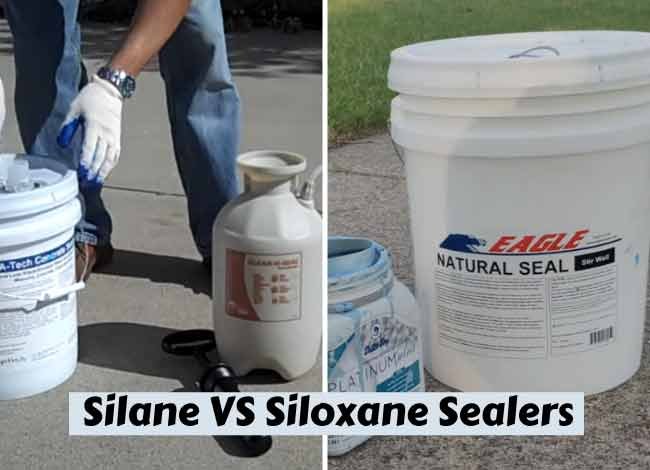Last Updated on May 12, 2025
When you walk into a store and ask for a concrete sealer, chances are you’ll be offered a variety of options—epoxies, urethanes, acrylic sealers, polyaspartics, and penetrating sealers. However, if you specifically ask for a penetrating concrete sealer, you’re most likely to be recommended either a silane or siloxane-based product. When comparing concrete sealers, the debate often comes down to one key choice: Silane vs Siloxane—two of the most effective penetrating sealers available.
Comparison: Silane vs Siloxane Sealers
Silane and siloxane are the two most common types of penetrating concrete sealers. Both are derived from the silicone family, offering excellent moisture protection, but they work in slightly different ways. The table below outlines their key differences:
Features |
Siloxane Sealer |
Silane Sealer |
|---|---|---|
| pH Dependence | Does not require high pH to activate | Requires high pH to catalyze |
| Penetration Depth | Stays near the surface for water repellency | Penetrates deeply to protect below the surface |
| Molecule Size | Larger molecules | Smaller molecules |
| Volatility | Less volatile | More volatile |
| Surface Appearance | May slightly darken the surface | Typically invisible once cured |
| Ideal Surfaces | Brick, stone, stucco | High-traffic areas like driveways, pool decks |
| Cost | Generally more affordable | Typically more expensive due to high solid content |
Key Differences Explained
- Silane Sealers have smaller molecules, allowing them to penetrate deeply into concrete, making them ideal for surfaces exposed to abrasion, weathering, or heavy traffic. However, they are more volatile and may lose some reactive material during application unless they have a high solids content.
Related: Asphalt VS Concrete Driveway: Which is Better?
- Siloxane Sealers, on the other hand, stay closer to the surface and are more effective for general water repellency. Their larger molecules mean less volatility, making them cost-effective for broader applications on porous surfaces like brick, stucco, and masonry.
Which One Should You Choose? Silane or Siloxane?
While both sealers have unique strengths, the best option often lies in combining both. Many high-performance products on the market today are silane/siloxane hybrid sealers, offering the deep penetration of silane with the surface-level water repellency of siloxane. These hybrids provide long-lasting protection both above and below the surface—ideal for driveways, patios, sidewalks, and pool decks.
Related: Driveway Sealer Spray VS Brush
Final Thoughts
Choosing between silane and siloxane sealers comes down to the surface type, exposure level, and your specific needs. If you’re sealing high-traffic, abrasion-prone surfaces, silane offers excellent durability. If your goal is to repel water on brick or stucco at a lower cost, siloxane might be the better choice. For comprehensive protection, a silane/siloxane hybrid sealer delivers the best of both worlds—ease of application and superior durability.
FAQs
What is the difference between silane and siloxane sealers?
Silane sealers penetrate deeper due to their smaller molecular size and offer below-surface protection, while siloxane sealers have larger molecules and provide surface-level water repellency. Silane typically requires a high-pH surface to catalyze, whereas siloxane does not.
Which is better for brick and stucco—silane or siloxane?
Siloxane sealers are generally better for brick, stucco, and other porous materials because they don’t rely on high-pH surfaces to work effectively and offer strong surface water resistance.
Do silane sealers last longer than siloxane sealers?
Yes, silane sealers typically offer longer-lasting protection, especially in areas exposed to abrasion or heavy weathering, as they penetrate deeper into the concrete or masonry.
Can I use silane or siloxane on a driveway?
Yes. Both silane and siloxane sealers can be used on driveways. Silane sealers are more durable for high-traffic areas, while siloxane sealers are easier to apply and more affordable for standard protection.
Will these sealers change the appearance of my surface?
Silane sealers usually do not change the surface appearance. However, siloxane sealers may slightly darken the surface, giving it a damp look.
Are silane/siloxane hybrid sealers better than using them individually?
In most cases, yes. A silane/siloxane hybrid combines the deep penetration of silane with the surface protection of siloxane, offering comprehensive coverage and long-lasting results.
How often should I reapply silane or siloxane sealers?
Silane sealers typically last 5–10 years, while siloxane sealers may need reapplication every 3–5 years, depending on exposure to weather, traffic, and surface type.
Can I apply these sealers myself, or do I need a professional?
Both silane and siloxane sealers can be applied by DIYers using a low-pressure sprayer or roller. However, proper surface preparation and adherence to manufacturer instructions are crucial for best results.
Do these sealers provide protection against oil and chemical stains?
Yes, both sealers offer protection against water, oil, and some chemicals, though silane sealers generally perform better in heavy-duty environments.
Are silane and siloxane sealers eco-friendly?
Many modern silane and siloxane products are low in VOCs and safer for the environment, but always check the product label or consult the manufacturer for specific environmental safety information.

